In my last article I talked about Pretty Fighter, an interesting series of fanservice fighting failures, and name dropped Variable Geo as one of its contemporaries. Whereas Pretty Fighter has a certain stench of slapdash cash-grab hanging over it, Variable Geo has proven to be a long running series spanning multiple game genres and media formats during its heyday.
Starting as an eroge fighter on the PC-98, the series has had multiple personal computer and home console releases with some sticking to the hentai roots and others being completely devoid of any ero content. Between visual novel spinoff and OVAs, the series proved to be popular for it’s decade-long tenure, but one release stands out among the pack for being a fighting game so enjoyable that it still sees tournament play to this day; Advanced Variable Geo 2 (stylized as Advanced V.G. 2).
At first blush AVG2 may not seem particularly special; a perfectly good looking PS1 fighter with cute anime girls utilizing a four-button system and a 3 bar super meter, it’s a little stock standard for the genre at this point. But when you dig under the surface of AVG2, you discover a game that is not only incredibly tight to play but features so many unique design decisions that few fighting games have ever followed in. Advanced Variable Geo 2 is packed to the gills with mechanical systems and character designs that are not only off the beaten path compared to its contemporaries, but would also not be seen moving forward.
Oh and I guess there’s a story to the game and the series as a whole about waitresses in a martial arts tournament where they promote the restaurant they work at ̶a̶n̶d̶ ̶n̶a̶u̶g̶h̶t̶y̶ ̶t̶h̶i̶n̶g̶s̶ ̶h̶a̶p̶p̶e̶n̶ ̶t̶o̶ ̶t̶h̶e̶ ̶l̶o̶s̶e̶r̶s̶ ̶d̶e̶p̶e̶n̶d̶i̶n̶g̶ ̶o̶n̶ ̶h̶o̶w̶ ̶e̶r̶o̶ ̶t̶h̶e̶ ̶g̶a̶m̶e̶ ̶i̶s̶ but who cares about that shit, we could be talking about 0f unblockables.
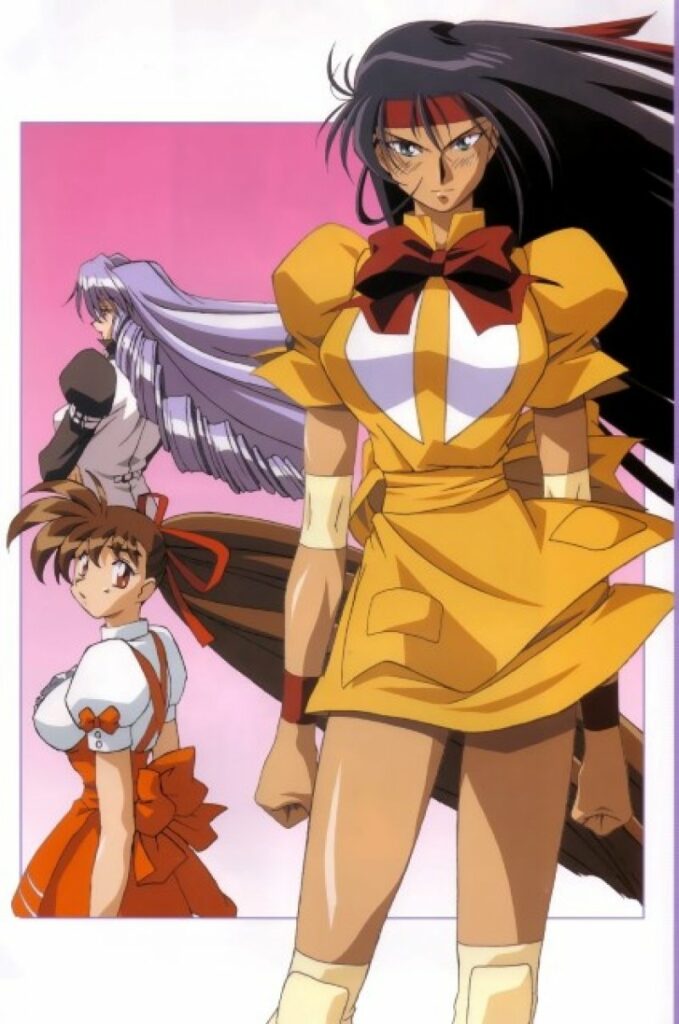
The art for the series also goes absolutely bananas.
Movement and System Mechanics
Advanced Variable Geo 2 is not an airdasher per say, but it heavily plays within the same space as that side of the genre. Whereas the concept of super jumps are typically used to gain additional vertical reach (think of the exhilaration in Capcom Versus games of super jumping and leaving the Earth behind), super jumps in AVG2 work in the same manner for horizontal space. Angled super jumps have extreme horizontal distance, creating a fast-paced aerial approach where you can cannonball yourself across the screen and score either a grounded or air conversion on your opponent. However, unlike a Melty Blood where this is one of many air options, these super jumps are the only movement tech and with how lucrative they can be in establishing yourself, players are incentivized to spend as much time in the air as possible. Air-to-air conversions lead to beefy combos and blessed are the few that have catch-all anti-air, especially invincible anti-air, options, so battling for dominance of the skies becomes a critical part of neutral.
But what makes those air-to-air clashes so damaging is the juggle system. AVG2 has an incredibly lax approach to comboability. Many games reign in their combo systems by hard-coding certain moves to allow juggle states (Ex: SF4’s Rufus has a juggle state on his jHK whereas his other air attacks cause air reset) or forcing the player to mitigate hitstun deterioration (Ex: UMvC3’s combo theory revolves around combining minimum hitstun states to not deteriorate out). In AVG2 as long as someone is in the air you can style on them like freeform jazz. It is up to you to figure out how to best keep an opponent in a juggle, be that combating distance with forward momentum or keeping the attack speed up with quick chains and cancels. The ability to cancel EXs into other EXs and Supers allows for extensions to be possible with the more meter you have on deck. The fun doesn’t stop when the opponent hits the ground, as every combo is allowed one incredibly free and easy OTG that pops the opponent back up.
What’s interesting is that unlike a regular juggle, which while loose in how you can play with it can still have opponents air reset out (like if you use the same normal too many times), after you OTG someone they cannot be air reset and will only recover on knockdown. With such open-ended tools for combo creativity, you may think that the game devolves into corner infinites, but shockingly AVG2 is entirely free of any juggle (stick a pin in this) infinites across it’s competitive landscape. With the right amount of resources, it’s possible to Touch of Death a lower defense value character, but no one in this game has a looping juggle infinite that either kills the opponent or timer scams the round. You get all of the creativity to craft beautiful swag juggles and nothing devolves into looking to score the round-ending infinite.
For how offensively based Advanced Variable Geo 2 is, it approaches defense in a particularly intriguing way. The game is almost bereft of true invincible reversals. Any anti-air or general Get Off Me special may contain invincibility frames, but only up until the attack is active. Yuka’s heavy Soryugeki is the only special (as far as we can tell) that retains a level of invincibility into her active frames, everything else falls off when the attack can hit. The flip side to this is that Guard Cancels in this game have the power to completely swing the pace of a match. While mostly operating the way Alpha Counters do, the Guard Cancels in AVG2 are secretly powerhouses in unexpected ways.
Unlike Alpha Counters, which offer a level of invincibility and a canned attack response that blows the opponent back, you get a different Guard Cancel for each of your four attack buttons and it’s not guaranteed they have invincibility. Typically your Guard Cancel options include two normals and two specials, you would think Guard Canceling into a jab would be weak but in AVG2 this is easily your best option. Because you don’t automatically knock the opponent back like in an Alpha Counter, Guard Canceling at the right time with a quick normal can lead into a full combo. This makes structuring offensive pressure tricky as its not invincible reversals you need to look out for, it’s having too obvious of a pressure string your opponent can blast through by Guard Canceling at the right time.
But this push and pull of how offense and defense is structured has one last element to it, and it’s probably the most defining aspect of Advanced Variable Geo 2.
Frame 0 Unblockables
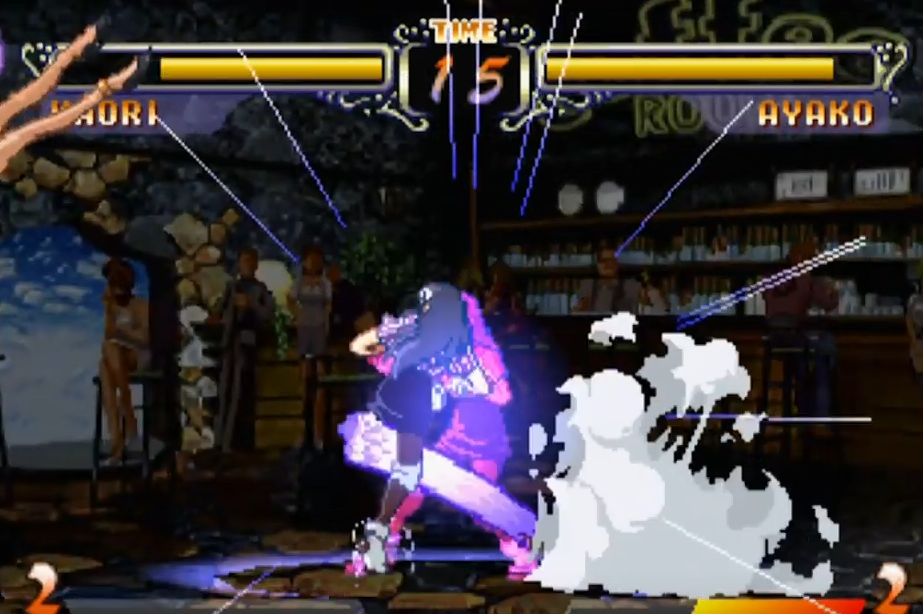
If you can see this, it’s likely already too late.
Every character in the game outside of two (and really, Jun is fine without it) has either EX moves, Supers, or both that are 0f Unblockables. These attacks have 0f of start up to them, so if you were not blocking before the super flash then your ass is getting hit. Despite their prevalence, they are not insurmountable. During the super flash, the opposing player can input a 0f super of their own or invincible reversal to combat it and with these 0f attacks lacking any sort of increased invincibility, they can still lose to meaty strikes. This plays further into AVG2’s design of Offensively Powerful, But Defensively Situational as having a 0f Unblockable can help in escaping pressure or anti-airing the opponent, but often will get you nowhere when under the threat of a simple fireball oki.
There is a subsection of these 0f Unblockables that, under the right situations, become truly unblockable even if the opponent is blocking before the super flash. But to explain that we need to explain Drawing Priority. When two characters are close enough to overlap, one of them will be in the foreground and one will be in the background, the one in the foreground has High Drawing Priority (HDP) and the one in the background has Low Drawing Priority (LDP). While in LDP, almost all 0f Unblockables will connect even if the HDP player is blocking before the super flash. Sadly Reimi and Tamao’s 0fs do not get this benefit, but everyone else has this true unblockable in their back pocket if they know they are going to be in LDP. What causes this switch between drawing priorities is generally that whoever last performed an attack will be given HDP, but there are a small amount of actions that force LDP. Most of these LDP forcing actions are irrelevant, for example Reimi, Tamao, and Jun can force LDP but lack the ability to do LDP 0f Unblockables, but Yuka being able to force LDP off her st.LK on hit or block is something worth looking out for.
As situational as LDP 0f Unblockables may be, standard 0f Unblockables are a core aspect of competitive AVG2 and it is hugely important not only to understand which 0fs your character has, but also which ones your opponent has as well. In a game with so few reliable invincible options, attacks that start up in 0f become the next best thing to have locked and loaded. Especially since these are not purely reversal options, but many of them can be used to start combos or link into themselves multiple times.
Roster Highlights
As much as the core system mechanics help differentiate Advanced Variable Geo 2 among other fighting games, its biggest strength is how interesting much of the roster is. Sure there are some reliable fighting game archetypes, Yuka is the default shoto, Tamao is a Dan Hibiki version of said shoto, Chiho is a a speedy ninja with standard high mobility countering low attack/defense values, but most of the roster have fascinating hybrid designs with toolkits that are so rarely seen elsewhere.
Kyoko
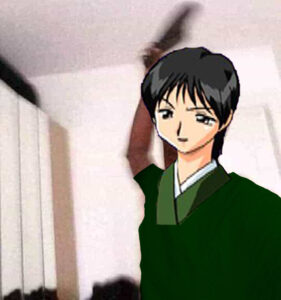
The last thing you see before jLP hits and you get aerial four-chained.
With command grabs, catch parries, and a rising anti-air grab, most would assume that Kyoko is one of the game’s grapplers. But in reality, she is a character with unique aerial dominance and the lone AVG2 girl who can setplay people to death. Almost every other character can only chain a light normal into a heavy normal when jumping, Kyoko can instead chain all four of her air normals together and overwhelm anyone who tries to stay in the top half of the screen. When she lands a conversion, her EX Sazanka scores a knockdown that allows her to set up an ambiguous left/right with her jHK. If the opponent guesses incorrectly on the mixup, Kyoko can combo off jHK into a route that builds back a fair amount of meter and leads into another EX Sazanka mixup. Despite these strengths, she is considered one of the weaker characters in the game because her grounded approach is so stubby that she can be boxed out with proper space control. But if Kyoko finds a way to fly in, she holds the ability to end the round with proper resources. That’s what constitutes “weak” in this game.
Satomi
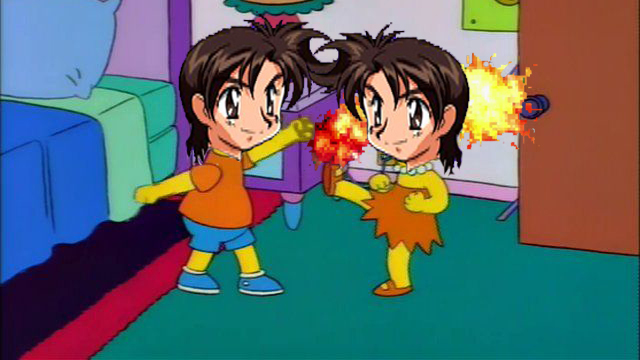
Average Satomi mirror.
On the opposite side of the spectrum, Satomi is a neutral monster with some of the strongest buttons in the game. Her stHP, crHP, and 3HK can bully the opponent and box them out of effective grounded ranges. If they think “well gosh, I should probably jump to get around this” they will be met with EX Kaenzan, the best anti-air in the game. Not only does EX Kaenzan have a huge enough hitbox to reliably catch crossups, but it will warp anyone it catches in front of Satomi so she can link another EX Kaenzan afterwards. While this sort of grounded and aerial space control would usually be enough, Satomi also has a projectile reflector (Ouhou) and a very fast overhead special (Gokeunsho) which becomes a combo tool as the EX version is a damaging extension she can link out of. She works as both a strong beginner-friendly character and can scale into a combo highlight real with tricky combo tools like Ouhou cancels and her daunting EX Shinku Karataki Wari extensions. Satomi is really, really good y’all.
Jun
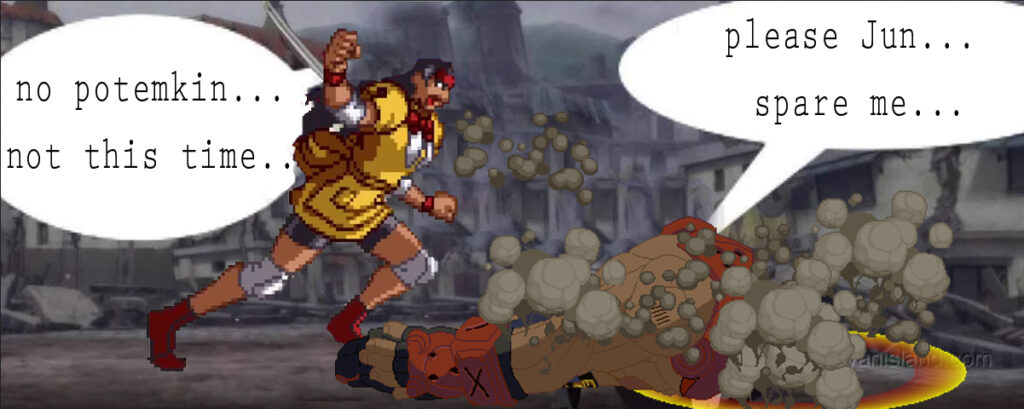
Back of the line, Old Man.
One of the few grapplers who can give AC Potemkin a run for his money, Jun is a miracle of a character. While one of the few characters to not have a 0f Unblockable, she is not hampered by such paltry deficiencies. So you know how grapplers usually lack movement options? Like being unable to forward dash or super jump like their peers? That does not happen in AVG2, Jun has just as much mobility as the rest of the cast. She may have slower normals, but she is not lacking in ability to approach. This is only scratching the surface of what makes Jun so wicked, she is able to combo after her command grab thanks to the power of EX Earth Shaker; basically Potemkin’s Slide Head but instead of knocking down it OTGs and pops the opponent up for a combo. Her knockdown comes in the form of Kubota Lariat, a combo ender that grants a rare hard knockdown (which again, you can OTG combo with EX Earth Shaker).
Not blessed enough by just being a offensive powerhouse, Jun also gets some of the best defensive tools in the game, while she lacks any sort of DP attack she instead gets Kubota Sway, a fully strike invincible spot dodge that doesn’t leave her punishable and can only be countered by throwing her. Finally, she has a glitch in her Guard Cancels where the normal she GCs with deals damage based on the attack she is Guard Canceling. This makes it so if she Guard Cancels an attack with high damage, she can melt the opponent just by chaining a couple jabs together. Jun is insane, she has more tools than a Home Depot and can run circles around any other grappler in the genre. If you are fond of this archetype, you owe it to yourself to see what an extremely powerful grappler looks like.
Ayako
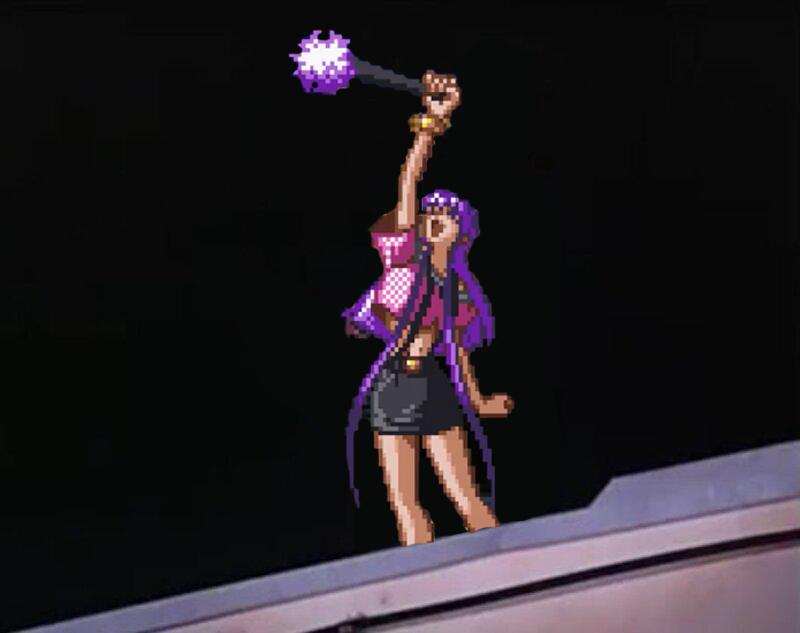
That’s The Wall, Brother.
We could call Ayako one of the “Rule Breakers” of AVG2, as she is allowed to do things that no other character could imagine. Ayako is typically a midrange bully, much like Satomi. She has a devastating stLK she can chain and combo from and her stHP is both a powerful anti-air and a launcher for combos. However, much like how Sol is secretly the best grappler in many versions of Guilty Gear, Ayako might tie Jun for strongest grappler in the game. Ayako’s only command grab is her super, but her normal throw is so powerful that she can combo from it anywhere on the screen. In the corner this becomes oppressive beyond belief, as she has combo routes for her throw both if and if you don’t try to tech. Thanks to this, her gameplay is controlling the opponent’s advance while backing them to the corner where she can tick throw them for a guaranteed combo.
While this is quite a tasty treat to have, this is pedestrian compared to her other character-specific benefit; a glitch that allows her to Guard Cancel in the air. Ayako is the lone character with the ability to reverse momentum in an air-to-air encounter, especially since her Heavy Punch Guard Cancel will activate her air throw if close enough. She can effectively stunt an opponent’s air advance by Guard Cancel throwing them, giving her the means to box out people both on the ground and in the air. While she may lack the damage of other strong characters, Ayako’s space control puts her as one of the strongest in the game.
Manami
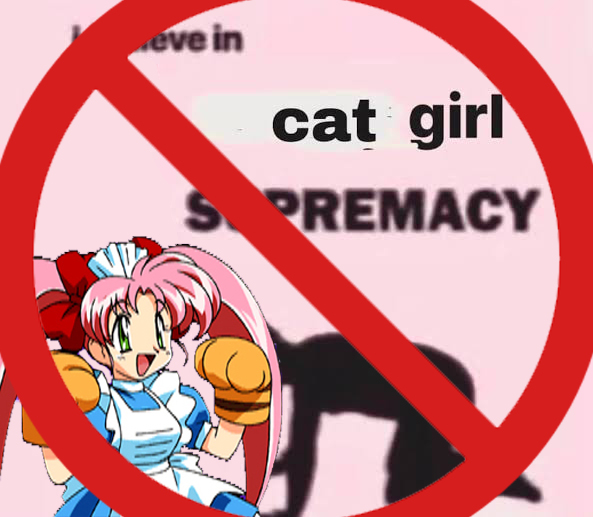
No.
Lol. Lmao. Manami sucks. Her normals are abysmal, her defensive value is the worst in the game, and it takes significant work to find her damage. There is no Tooth Fairy, there is no Queen of England, and there is no Catgirl supremacy to believe in. Not everyone is interesting because they are good.
Kaori

She can’t keep getting away with this. This is a real video you absolutely need to watch.
This unassuming nerd is the queen bee of AVG2. She breaks so many rules that she makes Ayoko look like someone who’s worst crime was stealing candy from the corner store. She is the reason we stuck a pin in saying this game had no juggle infinites. Kaori has a very simple grounded infinite, LP > LK > HP > HK, that’s it, loop until the next round starts. Kaori is definitively the Top 1 character in Advanced Variable Geo 2.
…But not because of her infinite.
See, the thing about Kaori is that her normals, both on the ground and in the air, are not particularly up to snuff compared to other top tiers. Outside of her ridiculous divekick that she can start the infinite off of, she’s likely going to be bullied with just her fists (or her feet really, all her normals are kicks) alone. So her optimal gameplan isn’t really to set up for her infinite, it’s there if she sees an opening or if she can Guard Cancel into it, but her main manner of dominance is being the best zoner in the game.
Kaori’s Ressenshuu is easily one of the best fireballs around and the EX version is one of her 0f Unblockables. When this is combined with her unstoppable crHP anti-air, Kaori becomes the best zoner on the roster. While it’s her strongest angle, it’s by no means her only one. Once she has established her game, she can either frustrate the opponent into moving or go in herself. Her 3-hit divekick makes her air advance incredibly effective, as she can go into her infinite off a successful divekick and if they block her coming down she can pressure the opponent with a proximity unblockable and two 0f Unblockables, one of which is unique as being the only 0f Unblockable in the game where the opponent cannot input a reversal during the super flash; it completely locks them out of response. Kaori is one of the strongest characters at range and up close she has way more tools to blow up downbackers and chicken blockers than any zoner should ever have. Oddly enough it is the midrange where she tends to struggle, as even with being the best character with a bullet she is by no means unbeatable. But yeah, having the only infinite in the game does help.
Wow This Sounds Like Such A Cool Game Played By Smart, Sexy People. Where Can I Learn More?
Top 3 for Advanced Variable Geo 2 @ Combo Breaker 2022!
1st: @MindGamesPro
2nd: @gyarugarou
3rd: @IdolismJBrackethttps://t.co/1eqTeUKudh pic.twitter.com/FL3fp9qi8o
— ☆「YASE」IdolismJ.bsky.social☆ (@IdolismJ) May 29, 2022
North American AVG2 players spotted in the meatspace, this is not a drill.
Even with this extended look at the game, there is so much more to AVG2 to discover; not even counting the characters I did not explain. We would be here all day if I attempted to prep you on every sick nuance and cool character attribute that hides inside. Thankfully, there is this really wicked website called SuperCombo (you’re on it right now, in case you were wondering) that hosts one of the most important wiki databases for fighting games. There is a wiki entry for AVG2 that contains the lion’s share of information on the game. It’s not fully updated as we are using the Japanese wiki for things like frame data and their wiki is also a little incomplete at the moment. If you are looking to find other people interested in the game, we have a Discord! Sadly, Advanced Variable Geo 2 is stuck on PS1 Island and has not made it to the Rollback Era, but it is playable online via NullDC BEAR.
There are some good video resources for the game out there if you can find it, thankfully I will just spill the secrets right here to get you on your way. BZ Choy’s YouTube channel has a large playlist of past tournament and casual footage, including the amazingly named Valkyrie Of The Glory tournament (raw, to be honest). The VERSUS PRINCESS combo video not only kicks off with the game’s sensational opening, but has 25min of combos that range from Somewhat Applicable to Hilariously Swaggy for every character. Finally, the Newcomer Challenge tournament in Japan wrapped up last month and I was so lucky to be able to do commentary for the English restream. Not only did this event have a great diversity across the roster, but there was an excellent showing by Lear; one of the top Japanese players and my favorite Ayako. The VOD is up on Sailor Vick’s YouTube channel and the full footage including casuals is up as well.
SailorVick also made this animation for Newcomer Challenge, marking the first time in eons that AVG2 received any sort of fan art.
Hopefully I’ve done enough to sell you on Advanced Variable Geo 2. A Japanese fighting game from a eroge series may set off a Kusoge Alarm for a lot of people, but this game is so far from that. A truly unique design of system mechanics and a tightly balanced roster with only occasional outliers makes Advanced Variable Geo 2 a solid game with both the competitive foundation and creative expression to rise above many of its contemporaries. Hopefully I can get another side event for it going at the next Frosty Faustings so you can find out that my Ayako’s throw resets are rated E for Everyone*.
*At the last North American tournament IdolismJ got 3rd and wasn’t even the best Ayako in bracket.

